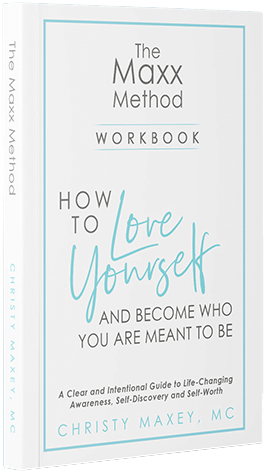wo facets of my MaxxMethod approach are thoughts and emotions. At the beginning of working on Personal Development, when asked how we feel, we often respond with a thought.
Since many of us have trouble identifying the difference between the two, I thought it would be an important topic. This first step is becoming aware of their difference and how each influences and shapes our lives. We are then better able to change our perspective and manage difficult emotions and negative thinking patterns.
Definition of Thoughts and Emotions
Thought
An idea or opinion produced through reason or deduction or occurring suddenly in the mind; cognition, an attitude, conception, or intellectual product – often articulated verbally within the mind, our inner monologue
Emotion
A natural state of mind deriving from one’s circumstances, mood, or relationships with others; feelings, a conscious mental reaction subjectively experienced and often felt in the body
One of the easiest ways to differentiate between emotions and thoughts is to think of emotions as something you feel (in the body or, for those spiritually inclined, in the soul) while a thought is something you actively think (verbalized within the mind).
There are a number of thoughts, attitudes, opinions, legends, myths, cultures, and customs to take into consideration; so many, that it would be impossible to calculate. But while our thoughts may differ in innumerable ways, our emotions—things like love, fear, anger, gratitude, joy, and sadness—are universal.
When it comes to our emotions they are quite difficult to dispute. When you feel sad, you are, well, sad! It is not a matter of opinion. You didn’t misinterpret that emotion, you feel it and it just is.
Thoughts on the other hand are malleable and they can often be misleading and flat out wrong. When we think to ourselves “I am not good enough” that is a thought and something we can change. We can then determine what thought is fueling our emotion. We can then fiercely challenge the thought and find evidence to dispute it. Therefore, we can address and comfort the fear and change the thought to “I am good enough.”
Not the Chicken or the Egg, But Rather the Yin and Yang
Anyone who has suffered with low self-esteem or anxiety knows that you cannot alter those emotions without making a conscious effort to alter your thinking. It does take effort. Research shows that it takes longer to change a negative thought to a positive thought; therefore, it does take practice.
A better way to view our thoughts and emotions and how they interact is not to think of the chicken and the egg—one coming first and leading to the other—but rather to view them as the yin and the yang. Two parts of our consciousness that feed off one another. Without emotions and just our thoughts we would conduct our affairs like robots. Without thinking and relying simply on our emotions, we would be about as functional as an infant.
Our thoughts and emotions exist in a symbiotic relationship—a shared and balanced ecosystem—that together, like the yin and yang, form a whole within us. They inform and complement each other; and just like any ecosystem, if one is out of tune or deficient, the other will be affected.

Mindfulness and Emotional Intelligence as Tools to Balance Our Thoughts and Emotions
Using methods such a mediation, we become aware of the differences between our thoughts and emotions. When we start as beginners, either in meditation or engaging in a breathing exercise, our mind often races so fast that we might conclude that there is no possible way for us to slow down our thoughts. In fact, Buddhist monks—having long recognized this issue—have given this annoyance a name: Monkey Mind!

What emotional intelligence teaches us about those thoughts is that they are not absolutes or undeniable facts; they can be—an often are—wrong! Through this understanding we become less dependent on those random thoughts that tell us that we are not good enough or things will never work out. We are training ourselves to think in ways that allow us to find meaning and joy in our lives, to love ourselves, and to show compassion for ourselves and others.
Self-Care is Worth the Effort
Therefore, if we make the effort to care for ourselves, we are investing in ourselves and our relationships. This effort means that we must understand the role our emotions and thoughts play in our life. We can then find a way to live more authentically and become who we know we are capable of being.
Of all the things we can do for ourselves, improving our emotional intelligence is an important one. When we work towards this end, everything else about ourselves (our health, relationships, job performance, self-esteem) will improve.


